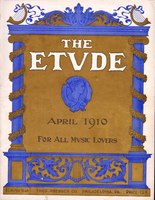A. P. H.—You are quite right as to the dates of the birth and death of Jacob Stainer—1621-1683. If the violin you speak of bears an earlier date, it is likely an imitation and not a genuine Stainer, always supposing that the violin bears the original date placed in it when the violin was made.
F. G. V.—Aug. Glass is not a violin maker of great note. A copy of a Stradivarius made by this maker would probably not be worth over $50, and might be worth much less. It would be impossible to give even an approximate value of the violin without seeing it.
E. H.—The inventor of the automatic violin player is H. K. Sandell. It has been patented in the United States and in Europe, and is now in general use as a novelty instrument, operated by electricity and set in motion by dropping a coin in the slot. It is used in hotel lobbies, cafés, etc.
V. S.—See article on "Fraudulent Labels" in The Etude for September, 1909. Only experts who have spent their lives in studying violins can decide if a violin is genuine. If your violin came originally from the Hill establishment in London, why not write to them, describing the violin, and asking for an opinion? The address is Wm. E. Hill & Sons, 140 New Bond street, London, Eng.
R. G.—The inscription in your violin means that it was made in the year 1791, in Mittenwald, by George Kloz. There was a violin maker of some note named George Klotz, born 1723, died 1797. The name is spelled "Klotz" and not "Kloz," as given in your label. If your violin is a good George "Klotz," in good preservation, it should be a fairly good instrument. There were at least eight makers of violins named Klotz, who made violins in the Mittenwald, headed by Matthias Klotz, who was the founder of the industry of violin making there. The violins are widely used, but do not compare in value with the violins of Cremona and with the best French makers.
J. P. W.—There are very few concertos for the violin which could be mastered by a pupil who is only in the beginning of Kreutzer. One which might prove what you want is the First Concerto in A minor by J. B. Accolay. For easy and effective solos try the Introduction and Polonaise, and the Steyrische Ländler by Bohm (from the Arabesken); also the Souvenir de Wieniawski by Haesche. 2. Violin teachers have different theories as to how soon the vibrato should be studied. It certainly should not be commenced until the pupil has a good, firm intonation in the first five positions of the violin. Any pupil who can play the first twelve etudes of Kreutzer in tune can safely begin the vibrato. Many eminent teachers discourage its early use, preferring to wait until the hand is well set to the instrument.
V. A. Y. Gut strings produce a much better tone than wire strings in any position, provided you use first-class Italian strings. Possibly the bad tone you complain of comes from the fact that in the higher positions you do not bow close enough to the bridge. The higher the position, the closer the bow must approach the bridge. 2. As self-instruction, in the right way, is impossible in violin playing, it is difficult to cite you to a "self-instructor" which will cover your needs, since the most eminent writers of exercises for violin study write their studies and methods in the expectation that they will be studied under a teacher, and so supply little descriptive matter. Possibly Dancla's "Conservatory Method," which contains a good deal of descriptive matter, might be what you want. Also get "Violin Technics," by Courvoisier, or, for a little work in popular style, "The Violin and How to Master It," by a Professional Player. The two latter contain no music.



